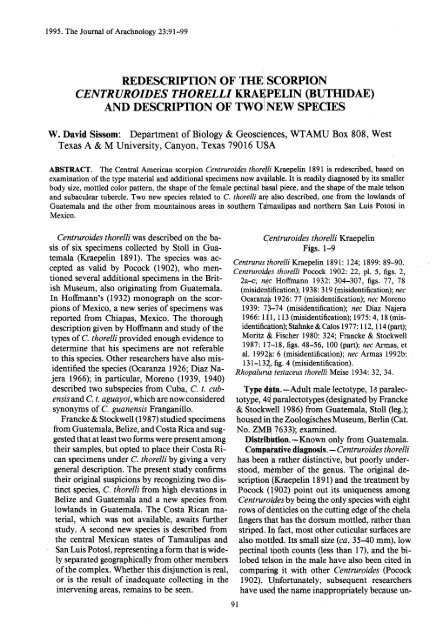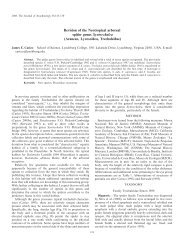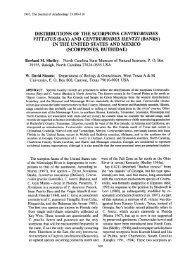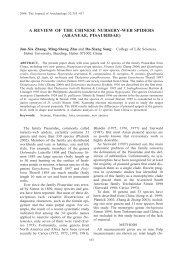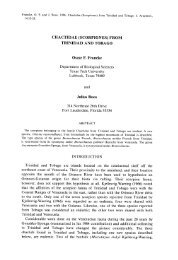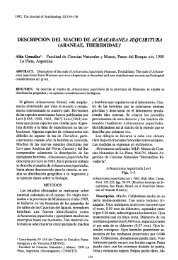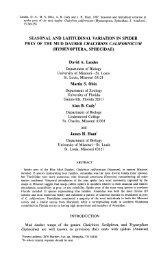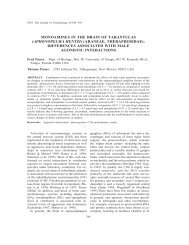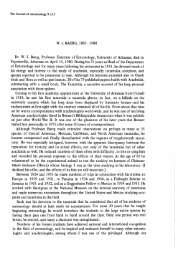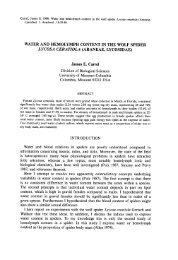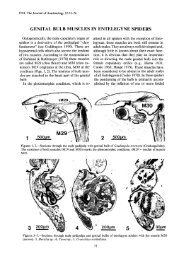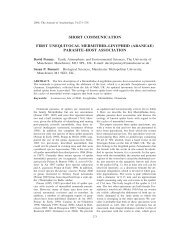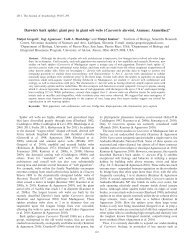redescription of the scorpio n centruroides thorelli kra}pelin
redescription of the scorpio n centruroides thorelli kra}pelin
redescription of the scorpio n centruroides thorelli kra}pelin
You also want an ePaper? Increase the reach of your titles
YUMPU automatically turns print PDFs into web optimized ePapers that Google loves.
1995 . The Journal <strong>of</strong> Arachnology 23 :91—9 9<br />
REDESCRIPTION OF THE SCORPIO N<br />
CENTRUROIDES THORELLI KRA}PELIN (BUTHIDAE)<br />
AND DESCRIPTION OF TWO NEW SPECIE S<br />
W. David Sissom : Department <strong>of</strong> Biology & Geosciences, WTAMU Box 808, Wes t<br />
Texas A & M University, Canyon, Texas 79016 USA<br />
ABSTRACT . The Central American <strong>scorpio</strong>n Centruroides <strong>thorelli</strong> Krae<strong>pelin</strong> 1891 is redescribed, based o n<br />
examination <strong>of</strong> <strong>the</strong> type material and additional specimens now available. It is readily diagnosed by its smalle r<br />
body size, mottled color pattern, <strong>the</strong> shape <strong>of</strong> <strong>the</strong> female pectinal bhsal piece, and <strong>the</strong> shape <strong>of</strong> <strong>the</strong> male telson<br />
and subaculear tubercle. Two new species related to C . <strong>thorelli</strong> are also described, one from <strong>the</strong> lowlands <strong>of</strong><br />
Guatemala and <strong>the</strong> o<strong>the</strong>r from mountainous areas in sou<strong>the</strong>rn Tamaulipas and nor<strong>the</strong>rn San Luis Potosi i n<br />
Mexico.<br />
Centruroides <strong>thorelli</strong> was described on <strong>the</strong> basis<br />
<strong>of</strong> six specimens collected by Stoll in Guatemala<br />
(Krae<strong>pelin</strong> 1891) . The species was accepted<br />
as valid by Pocock (1902), who mentioned<br />
several additional specimens in <strong>the</strong> British<br />
Museum, also originating from Guatemala .<br />
In H<strong>of</strong>fmann's (1932) monograph on <strong>the</strong> <strong>scorpio</strong>ns<br />
<strong>of</strong> Mexico, a new series <strong>of</strong> specimens wa s<br />
reported from Chiapas, Mexico . The thorough<br />
description given by H<strong>of</strong>fmann and study <strong>of</strong> th e<br />
types <strong>of</strong> C. <strong>thorelli</strong> provided enough evidence to<br />
determine that his specimens are not referabl e<br />
to this species . O<strong>the</strong>r researchers have also misidentified<br />
<strong>the</strong> species (Ocaranza 1926; Diaz Najera<br />
1966); in particular, Moreno (1939, 1940 )<br />
described two subspecies from Cuba, C . t. cubensis<br />
and C. t. aguayoi, which are now considered<br />
synonyms <strong>of</strong> C . guanensis Franganillo .<br />
Francke & Stockwell (1987) studied specimen s<br />
from Guatemala, Belize, and Costa Rica and sug -<br />
gested that at least two forms were present amon g<br />
<strong>the</strong>ir samples, but opted to place <strong>the</strong>ir Costa Rican<br />
specimens under C. <strong>thorelli</strong> by giving a very<br />
general description . The present study confirms<br />
<strong>the</strong>ir original suspicions by recognizing two distinct<br />
species, C. <strong>thorelli</strong> from high elevations i n<br />
Belize and Guatemala and a new species fro m<br />
lowlands in Guatemala . The Costa Rican material,<br />
which was not available, awaits fur<strong>the</strong>r<br />
study. A second new species is described from<br />
<strong>the</strong> central Mexican states <strong>of</strong> Tamaulipas an d<br />
San Luis Potosi, representing a form that is wide -<br />
ly separated geographically from o<strong>the</strong>r member s<br />
<strong>of</strong> <strong>the</strong> complex . Whe<strong>the</strong>r this disjunction is real ,<br />
or is <strong>the</strong> result <strong>of</strong> inadequate collecting in <strong>the</strong><br />
intervening areas, remains to be seen .<br />
Centruroides <strong>thorelli</strong> Krae<strong>pelin</strong><br />
Figs. 1-9<br />
Centrurus <strong>thorelli</strong> Krae<strong>pelin</strong> 1891 : 124; 1899 : 89—90 .<br />
Centruroiaes <strong>thorelli</strong> Pocock 1902: 22, pl. 5, figs. 2 ,<br />
2a—c; nac H<strong>of</strong>fmann 1932 : 304—307, figs. 77, 7 8<br />
(misidentification) ; 1938 : 319 (misidentification) ; nec<br />
Ocaranza 1926 : 77 (misidentification); nec Moreno<br />
1939: 73-74 (misidentification); nec Diaz Najera<br />
1966: 111, 113 (misidentification); 1975:4, 18 (misidentification)<br />
; Stahnke & Calos 1977 : 112, 114 (part);<br />
Moritz 4 Fischer 1980: 324; Francke & Stockwell<br />
1987 : 17—18, figs. 48—56, 100 (part) ; nec Armas, e t<br />
al. 19924: 6 (misidentification) ; nec Armas 1992b :<br />
131—1321, fig. 4 (misidentification) .<br />
Rhopalurus testaceus <strong>thorelli</strong> Meise 1934 : 32, 34 .<br />
Type data. —Adult male lectotype, 18 paralec -<br />
totype, paralectotypes (designated by Francke<br />
& Stockwell 1986) from Guatemala, Stoll (leg .) ;<br />
housed in, <strong>the</strong> Zoologisches Museum, Berlin (Cat .<br />
No. ZMI 7633) ; examined.<br />
Distrib tion . —Known only from Guatemala.<br />
Compa ative diagnosis . —Centruroides <strong>thorelli</strong><br />
has been a ra<strong>the</strong>r distinctive, but poorly understood,<br />
member <strong>of</strong> <strong>the</strong> genus. The original description<br />
Krae<strong>pelin</strong> 1891) and <strong>the</strong> treatment b y<br />
Pocock ( 902) point out its uniqueness among<br />
Centruroidesby being <strong>the</strong> only species with eight<br />
rows <strong>of</strong> dgnticles on <strong>the</strong> cutting edge <strong>of</strong> <strong>the</strong> chel a<br />
fingers that has <strong>the</strong> dorsum mottled, ra<strong>the</strong>r than<br />
striped. In fact, most o<strong>the</strong>r cuticular surfaces are<br />
also mottled. Its small size (ca . 35-40 mm), low<br />
pectinal tooth counts (less than 17), and <strong>the</strong> bilobed<br />
telson in <strong>the</strong> male have also been cited in<br />
comparing it with o<strong>the</strong>r Centruroides (Pocock<br />
1902). Unfortunately, subsequent researchers<br />
have used <strong>the</strong> name inappropriately because un -<br />
91
92 THE JOURNAL OF ARACHNOLOGY<br />
Figures 1—9.—Morphology <strong>of</strong> Centruroides <strong>thorelli</strong> Krae<strong>pelin</strong> 1891 . 1—6, Lectotype male . 1, Left lateral aspect<br />
<strong>of</strong> metasomal segments II1—V and telson; 2, Telson, enlarged view o left lateral aspect; 3, Telson, ventral aspect;<br />
4, Dorsal aspect <strong>of</strong> pedipalp femur; 5, Dorsal aspect <strong>of</strong> pedipalp p tella ; 6, External (lateral) aspect <strong>of</strong> pedipalp<br />
chela. 7—9, Paralectotype female . 7, Left lateral aspect <strong>of</strong> metasom~al segments III—V and telson ; 8, Telson,<br />
enlarged view <strong>of</strong> left lateral aspect; 9, Ventral aspect <strong>of</strong> sternum, genital opercula, and pectines.<br />
described mottled forms exist in sou<strong>the</strong>rn Mexico<br />
and Central America . Two <strong>of</strong> <strong>the</strong>se are described<br />
below and compared to <strong>the</strong> true C . Morelli<br />
.<br />
Description <strong>of</strong> lectotype male.—Coloration:<br />
Base color yellow to light yellow brown . Cara -<br />
pace with anterior margin infuscate and distinc t<br />
dusky marbling throughout . Tergites with dusky<br />
band along posterior margins ; anterior portion s<br />
<strong>of</strong> tergiteS with diffuse dusky markings ; each tergite<br />
bearing a narrow yellow median longitudina l<br />
line. Metasomal segments I—IV light yellow; V
SISSOM—CENTRUROIDES THORELLI AND RELATIVES 93<br />
and telson slightly darker . Cheliceral manus with carina weak, smooth ; ventrointernal carina moddusky<br />
marbling. Pedipalps and legs pale yellow, erate, irregularly serratocrenulate ; internal face<br />
with faint to moderate dusky markings. Venter with weak basal tubercle and several large gran -<br />
uniformly yellowish . Prosoma : Carapace mod- ules. Che a: (Fig. 6). Dorsomarginal, digital, and<br />
erately coarsely granular ; anterior median furrow ventroex ernal carinae weak, smooth ; dorsoindeep,<br />
rounded ; posterior median furrow deep, ternal carina obsolete except for a few coars e<br />
narrow near ocular tubercle and broadening pos- distal granules ; o<strong>the</strong>r carinae essentially obsolete .<br />
teriorly; carapacial carinae inconspicuous, indi- Fixed finger with eight oblique rows <strong>of</strong> granule s<br />
cated by medium-sized rounded granules . Me- (<strong>the</strong> two basal rows are virtually fused, separate d<br />
sosoma :Median carina on tergites I—II moderate, only by a tiny gap), flanked by supernumerary<br />
granular; on III—VI stronger, granular to crenu- granules . (Fixed finger trichobothrium db posilate.<br />
Pretergites minutely granular ; post-tergites tioned jut proximal to et . Movable finger with<br />
with large, smooth patches anterolaterally; pos- short api al row <strong>of</strong> four granules followed by<br />
terior third <strong>of</strong> each tergite moderately coarsely seven roVvs <strong>of</strong> oblique granules (actually eight<br />
granular. Tergite VII with strong, granular me- rows wit two basal rows fused); granular row s<br />
dian keel and two pairs <strong>of</strong> strong, irregularly flanked b supernumerary granules .<br />
crenulate lateral keels . Pectines : Basal piece about Morph metrics: See Table 1 .<br />
2.4 times wider than long with straight posterior Measurements <strong>of</strong>lectotype male: (in mm; L =<br />
margin; pectinal tooth count 16—16 . Sternites III— length, VW = width, D = depth). Total L, 36 .80 ;<br />
VI smooth; VII with submedian and lateral ca- carapace t.,, 3 .55 ; mesosoma L, 8 .90; metasoma<br />
rinae moderate, crenulate . Metasoma : (Fig. 1). L, 20.95 ; telson L, 3 .40. Metasomal segments: I<br />
Segments I—IV: Dorsolateral carinae on I strong, L/W, 3 .10/1 .65; II L/W, 3 .85/1 .60; III L/W, 4 .25/<br />
serratocrenulate; on II—III moderate, crenulate; 1 .55; IV L/W, 4 .70/1 .55 ; V L/W, 5 .05/1 .50 . Tel -<br />
on IV strong, crenulate . Lateral supramedian son : vesi le L/W/D, 2 .45/1 .30/1 .20; aculeus L ,<br />
carinae on I strong, serratocrenulate; on II—IV 0 .95. Pe pales: femur L/W, 3 .90/0.85; patella<br />
strong, crenulate. Lateral inframedian carinae on L/W, 4 .05/1 .20; chela L/W/D, 6 .20/1 .25/1 .30;<br />
I strong, serratocrenulate ; on II—IV absent. Ven- fixed fing r L, 3 .35; movable finger L, 3 .90; palm<br />
trolateral carinae on I moderate, granular to ir- (underha d) L, 2 .50 .<br />
regularly crenulate ; on II—IV strong, crenulate . Measu ements <strong>of</strong>paralectotype female : Total<br />
Ventral submedian carinae on I weak to mod- L, 38 .55; carapace L, 4 .30; mesosoma L, 11 .60 ;<br />
erate, granular; on II—IV strong, irregularly cren- metasoma L, 18 .85; telson L, 3 .80. Metasomal<br />
ulate. Segment V: Dorsolateral carina moderate segments ; I L/W, 2 .90/2.30; II L/W, 3 .55/2.20 ;<br />
and crenulate anteriorly, weak and granular pos- III L/W, 65/2 .05; IV L/W, 4.15/2.10; V L/W ,<br />
teriorly; lateromedian carina essentially obso- 4 .60/2 .0 . Telson: vesicle L/W/D, 2.50/1 .65/<br />
lete; ventrolateral and ventromedian carinae 1 .45 ; act leus L, 1 .30. Pedipalps : femur L/W,<br />
moderate, feebly crenulate . Intercarinal spaces 4 .10/1 .2q; patella L/W, 4 .35/1 .60; chela L/W/<br />
on all segments sparsely granular . Telson: (Figs. D, 7 .15/11 .45/1 .65; fixed finger L, 4 .00; movabl e<br />
2, 3). Vesicle distinctly bilobed ventrodistally ; finger L, 4 .65; palm (underhand) L, 2 .75 .<br />
aculeus downwardly deflected at junction with Variation .—Female morphology differs fro m<br />
vesicle. Subaculear tooth strong, spinoid; its point that <strong>of</strong> tk_e male as follows: <strong>the</strong> metasomal segdirected<br />
towards tip <strong>of</strong> aculeus. Ventral aspect ments are proportionately shorter (Fig . 7, Table<br />
<strong>of</strong> vesicle irregularly granular . Pedipalps: Ortho- 1), but <strong>the</strong> body excluding <strong>the</strong> metasoma is largbothriotaxia<br />
A (Vachon 1974) ; femur with al- er; <strong>the</strong> t lson vesicle is more bulbous; pectinal<br />
pha-configuration <strong>of</strong> dorsal trichobothria (Va- tooth co nts are slightly lower (see below) ; and<br />
chon 1975) . Femur: (Fig. 4) . Dorsointernal and <strong>the</strong> meta oma is more granular . The telson i s<br />
dorsoexternal carinae strong, serratocrenulate ; more evnly ovoid and is not distally bilobed<br />
ventrointernal carina strong, serrate; ventroex- (Fig. 8). he basal piece <strong>of</strong> <strong>the</strong> female pectine is<br />
ternal carina moderate, granular anteriorly and ei<strong>the</strong>r str 'ght or slightly convex (Fig . 9), similar<br />
strong, serrate posteriorly; internal and external to that o <strong>the</strong> male .<br />
intercarinal spaces with large coarse granules . Pa- Male ctinal tooth counts varied as follows :<br />
tella: (Fig. 5). Dorsointernal carina moderate, 3 combs with 17 teeth, 4 combs with 16 teeth ,<br />
finely serratocrenulate; dorsomedian and dor- and 9 cobs with 15 teeth; female counts varied<br />
soexternal carinae weak, granular ; external ca- as follow : 4 combs with 15 teeth, 9 combs wit h<br />
rina weak, more or less smooth ; ventroexternal 14 teeth, and 2 combs with 13 teeth (one comb
94 THE JOURNAL OF ARACHNOLOG Y<br />
Table l .-Morphometric comparisons between Centruroides <strong>thorelli</strong> Krae<strong>pelin</strong>, C. schmidti new species and<br />
C. rileyi new species . Ratios are as follows: 1 = carapace length/metasoma V length; 2 = pedipalp femur length/<br />
width ; 3 = pedipalp patella length/width ; 4 = metasoma III length/width ; 5 = metasoma V length/width; 6 =<br />
metasoma V length/depth; 7 = pedipalp chela width/pedipalp patella width ; 8 = pectinal basal piece width/<br />
length .<br />
Ratio<br />
<strong>thorelli</strong><br />
(n = 7)<br />
Males Females<br />
schmidti<br />
(n = 1)<br />
rileyi<br />
(n = 1)<br />
I, I<br />
<strong>thorelli</strong><br />
= 8)<br />
schmidt i<br />
(n = 1)<br />
rileyi<br />
(n= 3 )<br />
1 min 0.612 0.651 0.833 0.920 0.809 0.872<br />
max 0.725 0.967 0 .882<br />
2 min 4.059 4.000 3.438 3.417 3.600 3.056<br />
max 5.158 3.857 3.444<br />
3 min 3.000 2.818 2.652 2.719 2.645 2.34 5<br />
max 3.821 3.000 2.520<br />
4 min 2.621 3.450 2.609 1.610 2.552 2.250<br />
max 3.471 1.780 2.37 5<br />
5 min 3.241 4.300 3 .429 2.190 3.241 2.83 3<br />
max 4.344 2.361 3.000<br />
6 min 3.370 3.909 3.130 2.359 2.849 2 .61 5<br />
max 4.633 2.528 2.78 6<br />
7 min 0.917 0.818 0.783 0.893 0.774 0.75 9<br />
max 1 .107 0.968 0.84 0<br />
8 min 2 .100 1 .625 1 .556 1 .733 1 .250 1 .333<br />
max 2.625 2.364 1 .429<br />
was damaged and its teeth could not be counted) .<br />
In addition, <strong>the</strong>re were eight unsexed first instar<br />
specimens; among <strong>the</strong>se juveniles, <strong>the</strong>re were 2<br />
combs with 16 teeth, 5 combs with 15 teeth, and<br />
9 combs with 14 teeth .<br />
Color varied somewhat among <strong>the</strong> specimen s<br />
examined, with some individuals being lighte r<br />
in base color with less intense fuscosity. The differences<br />
may be due to preservation, although<br />
Centruroides spp. are known to exhibit considerable<br />
variation in <strong>the</strong>se characters.<br />
Comments . -H<strong>of</strong>fmann's (1932) specimens o f<br />
C. <strong>thorelli</strong> from Tuxtla Gutierrez, Chiapas and<br />
Francke & Stockwell's (1987) specimens fro m<br />
Costa Rica are not referable to C. <strong>thorelli</strong> . The<br />
latter authors noted significant differences between<br />
<strong>the</strong>ir specimens and <strong>the</strong> type series but<br />
opted not to describe <strong>the</strong>ir form as new. These<br />
specimens were not available for study. Although<br />
Armas (1992) reported only a small juvenile from<br />
Quintana Roo, I have been able to examine a<br />
mature female collected recently; as Armas has<br />
suggested (pers. comm .), it does not appear to b e<br />
referable to C. <strong>thorelli</strong> .<br />
Additional specimens examined .-GUATEMALA:<br />
Chichivac, near Tecpan (P. J. W . Schimdt, Leon Man -<br />
del Guatemala Expedition), 1 Feb 1934, la, 14, 8 first<br />
instars (FM NH) ; Finca San Rafael, Sacatepequez, elev.<br />
6900 ft ., w der bark (R. D . Mitchell), 24 June 1948 ,<br />
1 a (FMNH , 25 June 1948, la, 14, 1 juv male (WDS),<br />
29 June 1948, 2a, 22 (FMNH) .<br />
Cei}truroides schmidti new species<br />
(Figs. 10-18)<br />
Type dta.-Adult holotype male "found on<br />
bones <strong>of</strong> rocodile skull" at Lake Tickamaya ,<br />
Hondura on 26 April 1923 by K . Schmidt and<br />
L. Walter (Capt. Field Mus . Exped.); permanently<br />
de osited in <strong>the</strong> Field Museum <strong>of</strong> Natural<br />
History, hicago .<br />
Etymol gy.-The specific epi<strong>the</strong>t is a patronym<br />
hono g Dr. K. P. Schmidt, collector <strong>of</strong> <strong>the</strong><br />
type speci ens, for his many years <strong>of</strong> service to<br />
arthropo systematics at <strong>the</strong> Field Museum o f<br />
Natural 1istory.<br />
Distribution.-Known only from Honduras<br />
and easte Guatemala .<br />
Com ttive diagnosis.-Centruroides schmidti<br />
is similar to C . <strong>thorelli</strong>, but differs in <strong>the</strong> follow-<br />
ing characters : <strong>the</strong> mottling <strong>of</strong> <strong>the</strong> carapace, ter-<br />
gites, and legs is weaker ; <strong>the</strong> distal segments o f<br />
<strong>the</strong> metas ma and telson are much darker than<br />
<strong>the</strong> prece ing segments ; <strong>the</strong> male telson is not<br />
distally b i<br />
lobed as in C. <strong>thorelli</strong>; <strong>the</strong> male sub
SISSOM—CENTRUROIDES THORELLI AND RELATIVES 9 5<br />
Figures 10-18.—Morphology <strong>of</strong> Centruroides schmidti new spe ies . 10—15, Holotype male. 10, Left lateral<br />
aspect <strong>of</strong> metasomal segments III—V and telson ; 11, Telson, enl zed view <strong>of</strong> left lateral aspect; 12, Telson,<br />
ventral aspect; 13, dorsal aspect <strong>of</strong> pedipalp femur; 14, Dorsal asp ct <strong>of</strong> pedipalp patella; 15, External (lateral)<br />
aspect <strong>of</strong> pedipalp chela. 16—18, Paratype female . 16, Left lateral asp ct <strong>of</strong> metasomal segments III—V and telson ;<br />
17, Telson, enlarged view <strong>of</strong> left lateral aspect ; 18, Ventral aspect Of sternum, genital opercula, and pectines .<br />
aculear tubercle arises from a crenulated mid -<br />
ventral carina and is angular, ra<strong>the</strong>r than a single<br />
spinoid tooth ; metasomal segment V in <strong>the</strong> mal e<br />
is essentially acarinate, ra<strong>the</strong>r with <strong>the</strong> keels well<br />
developed ; chela fixed finger trichobothrium db<br />
is slightly distal to et (ra<strong>the</strong>r than proximal to<br />
it); <strong>the</strong> basal piece <strong>of</strong> <strong>the</strong> female pectines is produced<br />
distally into a rounded lobe, ra<strong>the</strong>r tha n<br />
being straight or slightly convex; and <strong>the</strong>re are<br />
several distinct morphometric differences (see<br />
Table 1) .<br />
Description <strong>of</strong> holotype male . — Coloration:<br />
Base color light yellow brown above with faint<br />
to moderate dusky markings on dorsum, chelicerae,<br />
pecipalps, legs, and sternites . Coloration<br />
fairly uniform except as follows: coxosternal region<br />
light yellow, pectines very pale yellow ,<br />
metasomal segment V and telson dark orange t o<br />
reddish rown ; cheliceral teeth and tip <strong>of</strong> aculeu s<br />
dark red lsh brown . Prosoma : Carapace moderately<br />
c arsely granular; anterior median furrow<br />
moderatOly deep; posterior median furrow shal-
96 THE JOURNAL OF ARACHNOLOG Y<br />
low anteriorly, deeper posteriorly ; carapacial carinae<br />
inconspicuous, indicated by lines <strong>of</strong> smal l<br />
granules . Mesosoma : Median carina on I—VI<br />
moderate, granular . Pretergites minutely granular,<br />
post-tergites moderately, coarsely granular<br />
throughout . Tergite VII with moderate, granular<br />
median keel and two pairs moderate, finely serrated<br />
lateral keels. Pectinal basal piece 1 .8 times<br />
wider than long; posterior margin distinctly<br />
rounded; pectinal tooth count 15—15 . Sternite s<br />
III—VI essentially smooth, with some fine granulation<br />
on VI; VII with submedian and lateral<br />
carinae moderate, finely serrate . Metasoma : (Fig .<br />
10). Segments I—IV : Dorsolateral carinae on I —<br />
II moderate, finely serrate; on III moderate, crenulate;<br />
on IV weak, smooth. Lateral supramedian<br />
carinae on I—III moderate, finely serrate ; on I V<br />
weak, smooth. Lateral inframedian carina on I<br />
moderate, serrate ; on II-IV absent . Ventrolateral<br />
carinae on I—III moderate, finely serrate; on IV<br />
moderate, feebly granular . Ventral submedia n<br />
carinae on I—III weak, finely serrate; on IV weak ,<br />
feebly serrate . Intercarinal spaces shagreened .<br />
Segment V: Acarinate, intercarinal spaces shagreened.<br />
Telson : (Figs. 11, 12). Vesicle elongat e<br />
oval in shape with gently rounded dorsal margin ;<br />
ventral aspect with row <strong>of</strong> small granules leading<br />
to subaculear tubercle; subaculear tubercle narrow,<br />
but angular in lateral view, its point directe d<br />
towards middle <strong>of</strong> aculeus . Ventral aspect <strong>of</strong> ves -<br />
icle shagreened . Pedipalps : Orthobothriotaxia A<br />
(Vachon 1974); femur with alpha-configuration<br />
<strong>of</strong> dorsal trichobothria (Vachon 1975). Femur:<br />
(Fig . 13). Dorsointernal, dorsoexternal, and ventrointernal<br />
carinae strong, serrate; ventroexternal<br />
carina weak, smooth basally, crenulate distally;<br />
internal face with serrated keel flanked b y<br />
accessory granules; dorsal face moderately granular.<br />
Patella: (Fig. 14). Ventrointernal carin a<br />
strong, serrate; dorsointernal, dorsomedian, dor -<br />
soexternal, and ventroexternal carinae moderate,<br />
row <strong>of</strong> foir apical granules followed by eight<br />
oblique rows <strong>of</strong> granules ; granular rows flanked<br />
by supernumerary granules.<br />
Morphcmetrics.—See Table 1 .<br />
Measurements<br />
<strong>of</strong> holotype male . —(in mm, L<br />
= length, W = width, D = depth). Total L ap-<br />
proximate<br />
y 32 mm (tip <strong>of</strong> aculeus <strong>of</strong> telson broken,<br />
rendering total length an estimate) ; carapac e<br />
L, 2.80; Treaosoma L, 8.10; metasoma L, 17 .20 ;<br />
telson L, ?Metasomal segments: I L/W, 2 .50/<br />
1 .15 ; II LYW, 3 .05/1 .05 ; III L/W, 3 .45/1 .00 ; I V<br />
L/W, 3 . 9 /1 .00; V L/W, 4 .30/1 .00 . Telson : ves -<br />
idle L/W D, 1 .75/080/0.85 . Pedipalps: femu r<br />
L/W, 2 . 8 /0.70; patella L/W, 3 .10/1 .10; chel a<br />
L/W/D, .70/0.90/0.95; fixed finger L, 2 .85 ;<br />
movable tiger L, 3.20; palm (underhand) L, 1 .65 .<br />
Measurements <strong>of</strong> paratype female .—Total L ,<br />
37 .35; carapace L, 3 .80; mesosoma L, 11 .20; metasoma<br />
L, 18 .95; telson L, 3.40 . Metasomal segments:<br />
I L/W, 2 .90/1 .55; II L/W, 3 .45/1 .45; III<br />
L/W, 3 .70/1 .45 ; IV L/W, 4 .20/1.45 ; V L/W, 4 .70/<br />
1 .45 . Tel on: vesicle L/W/D, 1 .90/1 .10/1 .25 ;<br />
aculeus L, 1 .50 . Pedipalps : femur L/W, 3 .60/1.00;<br />
patella L/ , 4.10/1 .55; chela L/W/D, 6 .30/1 .20/<br />
1 .35; fixe finger L, 3 .90; movable finger L, 4.50 ;<br />
palm (un erhand) L, 2 .10 .<br />
Variation . — Only <strong>the</strong> holotype male and para-<br />
type fema<br />
differs fro<br />
<strong>the</strong> meta s<br />
16), and<br />
ulated ve<br />
<strong>the</strong> telson<br />
<strong>the</strong> basal<br />
into a larg<br />
counts in<br />
male cou<br />
14 .<br />
e were available for study. The female<br />
n <strong>the</strong> male in <strong>the</strong> following characters:<br />
>mal segments are not as elongate (Fig .<br />
ietasoma V bears well developed cren-<br />
itrolateral and ventromedian carinae ;<br />
is slightly more globose (Fig. 17); and<br />
piece <strong>of</strong> <strong>the</strong> pectins is produced distally<br />
rounded lobe (Fig. 18). Pectinal tooth<br />
<strong>the</strong> male and female were similar: <strong>the</strong><br />
t was 15—15 and <strong>the</strong> female count 15 —<br />
Paratypes .—GUATEMALA: Escobas, Iza -<br />
bal, 27 Ncvember 1933 (K. P. & P . J . W. Schmidt ,<br />
Leon Mandel Guatemala Exped .), is (FMNH) .<br />
finely serrate; external carina moderate, feebl y<br />
serrate ., Inner face with seven larger sharp , sub -<br />
conical granules . Chela : (Fig. 15). Dorsomarginal<br />
U{entruroides rileyi new specie s<br />
carina moderate, finely serrate; dorsal secondary<br />
Figs. 19—2 7<br />
carina moderate, granular to feebly crenulate; Type d ta.—Adult holotype male and adul t<br />
digital carina weak, smooth; external secondary paratype emale from Bocatoma (= 7 km SS E<br />
carina weak, smooth; ventroexternal carina Gomez Frias), Tamaulipas, Mexico on 25-3 0<br />
moderate, feebly granular; dorsointernal and March 1 78 by E. G. Riley; permanently deventrointernal<br />
carinae with relatively large, ser- posited in <strong>the</strong> collection <strong>of</strong> <strong>the</strong> United States Narate<br />
granules. Fixed finger with eight oblique rows tional Museum (Smithsonian), Washington, D . C .<br />
<strong>of</strong> granules, <strong>the</strong>se flanked by supernumerary Etymology .—The specific name is a patronym<br />
granules . Fixed finger trichobothrium db posi- honoring Dr. Edward Riley <strong>of</strong> Texas A & M<br />
tioned just distal to et . Movable finger with short University, <strong>the</strong> collector <strong>of</strong> <strong>the</strong> holotype .
SISSOM—CENTRUROIDES THORELLI AND RELATIVES 9 7<br />
Figures 19—27 .—Morphology <strong>of</strong> Centruroides rileyi new species. 19—24, Holotype male. 19, Left lateral aspect<br />
<strong>of</strong> metasomal segments III—V and telson ; 20, Telson, enlarged view <strong>of</strong> left lateral aspect ; 21, Telson, ventral<br />
aspect; 22, Dorsal aspect <strong>of</strong> pedipalp femur ; 23, Dorsal aspect <strong>of</strong> pedipalp patella; 24, External (lateral) aspect<br />
<strong>of</strong> pedipalp chela. 25—25, Paratype female. 25, Left lateral aspect <strong>of</strong> metasomal segments III—V and telson ; 26 ,<br />
Telson, enlarged view <strong>of</strong> left lateral aspect; 27, Ventral aspect <strong>of</strong> sternum, genital opercula, and pectines .<br />
Distribution.—Known from several localities<br />
in sou<strong>the</strong>rn Tamaulipas and nor<strong>the</strong>rn San Luis<br />
Potosi, Mexico.<br />
Comparative diagnosis .—Centruroides rileyi is<br />
most similar to C . schmidti, but is clearly relate d<br />
to C. <strong>thorelli</strong> as well. Unlike <strong>the</strong> o<strong>the</strong>r two species,<br />
sexual dimorphism in <strong>the</strong> length <strong>of</strong> th e<br />
metasomal segments is not as pronounced ; male<br />
segments are more slender but not noticeably<br />
longer than those <strong>of</strong> <strong>the</strong> female . Based on th e<br />
material at hand, C. rileyi exhibits smaller body<br />
2 1<br />
size tha ei<strong>the</strong>r C. <strong>thorelli</strong> or C. schmidti . The<br />
shape <strong>of</strong> a subaculear tubercle is similar to that<br />
<strong>of</strong> C. sc midti, developed from a distinct ventromedi<br />
keel. Likewise <strong>the</strong> basal piece <strong>of</strong> <strong>the</strong><br />
female p ctines is produced distally into a rounded<br />
lobe, feature seen in C. schmidti but not in<br />
C. <strong>thorelli</strong> . Among specimens available, female<br />
pectinal tooth counts were slightly lower than in<br />
C. schmidti, with a range <strong>of</strong> 11—13 (13—15 in C .<br />
<strong>thorelli</strong> and 14—15 in C. schmidti) . Metasomal<br />
segment ,V in <strong>the</strong> male <strong>of</strong> C. rileyi bears distinct
98 THE JOURNAL OF ARACHNOLOGY<br />
(but weak) crenulate carinae ; <strong>the</strong>se carinae are leading to<br />
developed in C. <strong>thorelli</strong>, but not in C. schmidti . cle narro<br />
The dorsal carinae <strong>of</strong> <strong>the</strong> pedipalp chelae are directed t<br />
moderately to strongly developed and distinctly pect <strong>of</strong> v<br />
crenulate, but are feeble and smooth to granular thobothri<br />
in C. <strong>thorelli</strong> and only <strong>the</strong> dorsal marginal carina alpha-con<br />
subaculear tubercle; subaculear tuber-<br />
, but angular in lateral view, its poin t<br />
wards middle <strong>of</strong> aculeus. Ventral as -<br />
side lightly granular . Pedipalps : Or -<br />
taxia A (Vachon 1974); femur with<br />
Oration <strong>of</strong> dorsal trichobothria (Va -<br />
), Femur : (Fig . 22) . All carinae strong ,<br />
is noticeably crenulated in C. schmidti . Mor- chon 19 7<br />
phometric comparisons are provided in Table 1 . serrate; insrnal face with series <strong>of</strong> large serrate<br />
Description <strong>of</strong> holotype male.—Coloration: granules ; 4rsal face moderately granular. Pa-<br />
Base color yellow to light yellow brown . Caratella: (Fig.' 23). Dorsointernal carina moderate ,<br />
pace with distinct dusky marbling concentrate d serrate; ddruomedian<br />
and dorsoexternal carinae<br />
mostly in median area. Tergites with distinct, strong, set atocrenulate; external carina strong,<br />
regular pattern <strong>of</strong> blackish spots. Metasomal seg- feebly cre ulate; ventroexternal carina moderments<br />
I—IV light yellow, moderately infuscate ; V ate, crenu ate; ventrointernal carina moderate ,<br />
and telson more heavily infuscate, appearing irregularly serrate. Inner face with eight to ten<br />
darker than preceding segments . Cheliceral ma- larger, shy rp, subconical granules. Chela: (Fig.<br />
nus with strong dusky marbling. Pedipalps and 24). Dorss marginal carina strong, coarsely crenlegs<br />
yellow, with distinct dusky markings . Venter ulate; dory 1 secondary carina strong, finely seruniformly<br />
yellowish anteriorly; sternites lightly rate; digit 1 and external secondary carinae mod -<br />
infuscate . Prosoma: Carapace moderatel y erate, fin ly crenulate; ventroexternal carin a<br />
coarsely granular; anterior median furrow mod- strong, fi] ely crenulate; ventrointernal carina<br />
erately deep ; posterior median furrow shallow<br />
anteriorly, deeper posteriorly ; carapacial carinae<br />
moderate with a few rounded granules ; dorsoin -<br />
ternal carii a strong, coarsely serrate . Fixed finger<br />
weak, indicated by lines <strong>of</strong> small granules . Me- with eig h oblique rows <strong>of</strong> granules flanked by<br />
sosoma: Median carina on tergites I—IV mod- supernum rary granules. Fixed finger trichoerate,<br />
granular ; on V—VI moderate, granular to bothrium db positioned just distal to et. Movable<br />
crenulate. Pretergites minutely granular, post- finger with short apical row <strong>of</strong> four granules fol -<br />
tergites with large, smooth patches anterolater- lowed by ight oblique rows <strong>of</strong> granules ; granular<br />
ally; posterior third <strong>of</strong> each tergite moderately, rows flan ed by supernumerary granules .<br />
coarsely granular. Tergite VII with moderate , Morph metrics . —See Table 1 .<br />
granular median keel and two pairs strong, finely Measu r ments <strong>of</strong> holotype male . —(in mm; L<br />
serrated lateral keels. Pectinal basal piece 1 .6 = length , = width, D = depth) . Total L, 29 .75 ;<br />
times wider than long; posterior margin distinct- carapace , 3.00; mesosoma L, 9 .10; metasoma<br />
ly rounded; pectinal tooth count 14—14 . Sternites L, 15 .15 ; elson L, 2 .50 . Metasomal segments: I<br />
III—VI essentially smooth ; VII with submedian L/W, 2 .3 5 1.30; II L/W, 2 .80/1.20; III L/W, 3 .00/<br />
carinae weak, granular and lateral carinae mod- 1 .15 ; I V W, 3.40/1 .05; V L/W, 3 .60/1 .05 . Telerate,<br />
finely serrate . Metasoma : (Fig. 19). Seg- son : vesic e L/W/D, 1 .50/0 .80/0 .90; aculeus L,<br />
ments I—IV : Dorsolateral carinae on I—II strong , 1 .00 . Ped alps : femur L/W, 2 .75/0.80; patella<br />
finely serrate ; on III strong, irregularly crenulate ; L/W, 3 .0 /1 .15 ; chela L/W/D, 4 .75/0.90/1 .05 ;<br />
on IV moderate, crenulate. Lateral supramedian fixed finge L, 2.85; movable finger L, 3 .25; palm<br />
carinae on I —III strong, finely serrate ; on IV strong, (underha (I) L, 1 .65 .<br />
feebly serrate. Lateral inframedian carina on I Measur ments <strong>of</strong> female paratype . —Total L,<br />
strong, finely serrate ; on II—IV absent. Ventro- 29 .85; car pace L, 3 .15 ; mesosoma L, 9 .40; me -<br />
lateral carinae on I—III strong, finely serrate; on tasoma L, 14 .65; telson L, 2 .65 . Metasomal seg-<br />
IV strong, feebly serrate. Ventral submedian ca- ments : I l/W, 2.25/1 .40; II L/W, 2 .65/1 .25; III<br />
rinae moderate, feebly serrate; on IV weak, feebly L/W, 2 .85/1 .20; IV L/W, 3 .30/1 .20 ; V L/W, 3 .60/<br />
serrate. Segment V: Dorsolateral carina moder- 1.20 . Tel on. vesicle L/W/D, 1 .45/0.85/0.95 ;<br />
ate, feebly granular ; lateromedian carina obso- aculeus L , 1 .20 . Pedipalps: femur L/W, 2 .75/0.85 ;<br />
lete; ventrolateral and ventromedian carinae patella L/ ' V, 3 .15/1.25 ; chela L/W/D, 4 .90/1 .05/<br />
moderate, feebly serrate . All metasomal inter- 1 .10 ; fixe s finger L, 3 .00; movable finger L, 3 .45 ;<br />
carinal spaces sparsely granular. Telson : (Fig. 20— palm (un erhand) L, 1 .60 .<br />
21). Vesicle elongate oval in shape with aculeus Variati~ n. —Only a single adult male is known;<br />
moderately deflected downward ; ventral aspect however, :here are three adult female specimen s<br />
with median longitudinal row <strong>of</strong> small granules and a ju` enile. Females differ from <strong>the</strong> males
SISSOM—CENTRUROIDES THORELLI AND RELATIVES<br />
only slightly in metasomal morphometrics with Diaz Naj ra, A. 1966. Alacranes de la Republic a<br />
<strong>the</strong> male metasoma being scarcely longer, but Mexica a. Cave para identificar especies de Cen -<br />
noticeably thinner (Fig. 25). There is also little trurus Scorpionida, Buthidae). Rev. Inst. Salubr.<br />
difference in <strong>the</strong> shape <strong>of</strong> <strong>the</strong> telson (Fig. 26). Enferm. Trop., Mexico, 26 :109—129 .<br />
Diaz Naj<br />
Finally, <strong>the</strong> female pectinal basal piece is progeogr<br />
duced distally into a distinct, rounded lobe (Fig . Rev R v . I<br />
27). Female pectinal tooth counts were as fol- Franke ,<br />
lows: <strong>the</strong>re were one comb with 11 teeth, four (Arach<br />
combs with 12 teeth, and one combs with 13 as Tec<br />
teeth .<br />
Paratypes . —MEXICO : San Luis Potosi, 5 km<br />
N Tamazunchale <strong>of</strong>f Hwy 85, 1 August 1987 (J .<br />
A. Nilsson), 19 (JAN) . Tamaulipas, Gomez Farias,<br />
16 March 1977 (R. Schmidt), 12 (FSCA) .<br />
H<strong>of</strong>fman<br />
Segun<br />
2:24 3<br />
H<strong>of</strong>fman<br />
erca d<br />
Mexic<br />
ACKNOWLEDGMENTS<br />
Kraepeli<br />
Familie der Androctonidae . Jahrb . Hamburg Wiss.<br />
I am extremely grateful to Manfred Moritz <strong>of</strong> Anst ., 8 :1—144 .<br />
<strong>the</strong> Zoologisches Museum in Berlin for allowing Meise, W. 1934. Scorpiones . Nytt. Mag. Naturvime<br />
to examine <strong>the</strong> type series <strong>of</strong> Centruroides densk , Oslo, 72:25-43 .<br />
<strong>thorelli</strong>. Additional material used in <strong>the</strong> descrip- Moreno, A . 1939. Contribucion al estudio de los estions<br />
was made available through <strong>the</strong> courtesy corpianidos cubanos. II. Superfamilia Buthoidea .<br />
<strong>of</strong> Dan Summers <strong>of</strong> <strong>the</strong> Field Museum <strong>of</strong> Natural<br />
History, Chicago (FMNH) ; Jan Nilsson <strong>of</strong><br />
Mem. Soc. Cubana Hist. Nat., 13 :63—75 .<br />
Moreno, A. 1940.<br />
a, A. 1975. Listas y datos de distribution<br />
c de los alacranes de Mexico (Scorpionida).<br />
t. Salubr. Enferm. Trop., Mexico, 35 :1—36 .<br />
F. & S. A. Stockwell. 1987. Scorpions<br />
ida) from Costa Rica . Spec. Publ. Mus. Tex-<br />
Univ., 25 :1—64 .<br />
C. C. 1932. Los Scorpiones de Mexico .<br />
parte. Buthidae. An. Inst . Biol ., Mexico ,<br />
361 .<br />
C. C. 1938. Nuevas consideraciones aclos<br />
alacranes de Mexico. An. Inst. Biol.,<br />
9 :317—337 .<br />
K. 1891 . Revision der Skorpione . I. Die<br />
Nor<strong>the</strong>rn Arizona University (JAN); Edward<br />
Riley <strong>of</strong> Texas A & M University; and Dougla s<br />
Rossman <strong>of</strong> Louisiana State University, whose<br />
specimens are now deposited in <strong>the</strong> Florida Stat e<br />
Collection <strong>of</strong> Arthropods (FSCA). Luis F. de Armas<br />
(Instituto de Ecologia y Sistematica, Aca-<br />
Scorpiologia cubana. Rev. Univ .<br />
Hava a, Cuba, 26/27 :91—113 .<br />
Moritz , . & S.-C. Fischer. 1980. Die Typen der<br />
Arac niden-Sammlung des Zoologischen Museum s<br />
Berli . III. Scorpiones. Mitt . Zool. Mus . Berlin., 56 :<br />
309 — 26 .<br />
Ocaran a, F. 1926. Estudio experimental acerca de<br />
la po ona de los alacranes en Mexico. Cuarta Medemia<br />
de Ciencias de Cuba) allowed me to ex - moil - Alacran de Sonora (Centrurus thorelh) rata<br />
amine his specimen from Quintana Roo as a loan blan a. Rev. Mexicana Biol., 6:77—80 .<br />
arranged through Norm Platnick <strong>of</strong> <strong>the</strong> American<br />
Museum <strong>of</strong> Natural History, New York; I<br />
am grateful to <strong>the</strong>m both for this courtesy . Lastly ,<br />
page charges were paid by <strong>the</strong> Department <strong>of</strong><br />
Biology & Geosciences <strong>of</strong> West Texas A & M<br />
University, and I am ever grateful for <strong>the</strong> sup -<br />
port .<br />
Pocock, R. 1902. Arachnida : Scorpiones, Pedipalpi ,<br />
and Solifugae . Pp . 1—71 In Biologia Centrali-Americanz,<br />
London.<br />
Stahnke, H . L. & M . Calos. 1977 . A key to <strong>the</strong> species<br />
<strong>of</strong> th ! genus Centruroides Marx (Scorpionida: Buthidae)<br />
. Ent. News, 88 :111—120.<br />
Vachon, M. 1974. Etude des caracteres utilises pour<br />
clas er les families et les genres de Scorpions (Ar-<br />
LITERATURE CITED<br />
ach ides) . Bull. Mus . Natn. d'Hist . Nat. (Paris), ser .<br />
3, 1 4 :857—958 .<br />
Vacho , M. 1975. Sur 1'utilisation de la trichobothrio<br />
xie du bras des pedipalpes des <strong>scorpio</strong>ns (Arach<br />
ides) daps le classement des genres de la famille<br />
des uthidae Simon. C. R. Acad. Sci. (Paris), ser.<br />
D, 81 :1597—1599 .<br />
Armas, L. F. de. 1992. Scorpiones y solpugida<br />
(Arachnida) de los Reserva de la Biosfera de Sian<br />
Ka'an, Quintana Roo . Pp. 129—137 In Nararro L.,<br />
D. & E. S. Morales (eds.), Diversidad Biologica en<br />
la Reserva de la Biosfera de Sian Ka'an Quintan a<br />
Roo, Vol . II. Centro de Investigaciones de Quintana<br />
Roo, Chetumal .<br />
Armas, L. F. de, D . Navarro L., & R. M. Medrano .<br />
1992. Apuntes para el estudio de los alacrane s<br />
(Arachnida: Scorpiones) de Quintana Roo . Ava-<br />
Cient. 3 :3—7.<br />
Manuscript received 15 February 1994, revised 9 May<br />
1995.<br />
99


